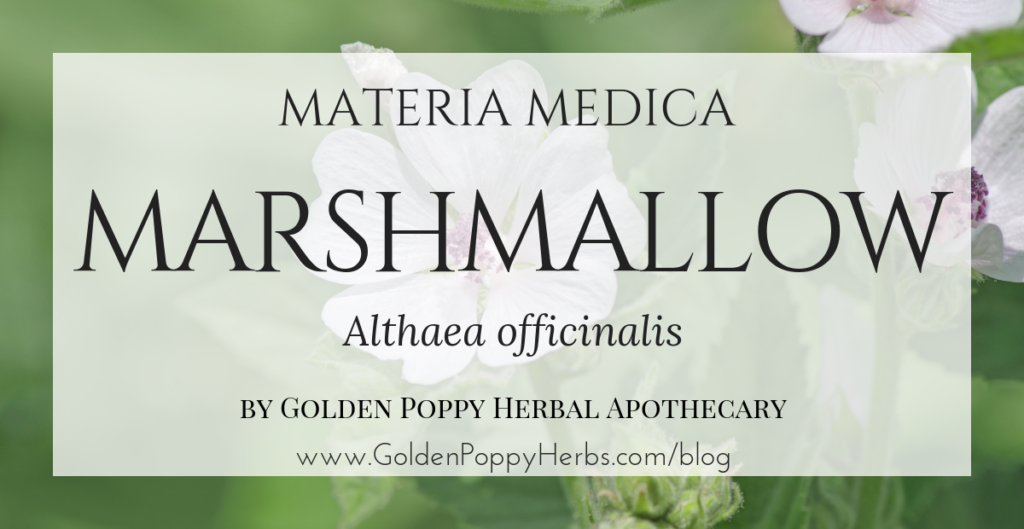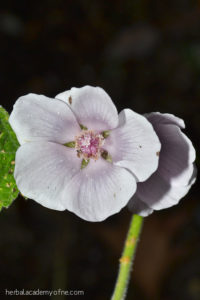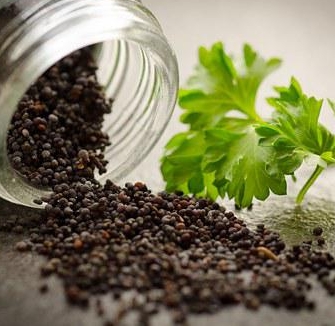
No we aren’t talking about the fluffy white things you add to hot chocolate, though that is a modern adaptation of what was once a traditionally prepared food.
We’re talking about the Marshmallow plant Athaea officianlis. Marhsmallow is one of our go-to plants for all manner of health concerns, mainly for it’s ability to help bring moisture into the body and soothe irritated tissues.
These two properties together make this plant a powerhouse in the medicinal herb world.
There are a wide variety of scenarios where you may want something soothing and moistening. A dry irritated cough, a dry and sore throat, dehydration, dry skin, irritated digestive tract, red and itchy eyes, you think of it, marshmallow is probably a sure bet.
Most of the medicinal plants we work with are drying in nature, not all of them, but most of them. Make a list of all the drying plants and then one of all the moistening plants and the list will be heavily weighted in favor of the dry. Because of this, us herbalists tend to use the moistening plants heavily to help balance out our formulas, and for scenarios where you need to add moisture to a body system (like those mentioned above).
Marshmallow is the premier moisture plant. Add it to a glass of cool water and you’ll see the mucilaginous compound turn the water thick. These compounds hold the water and help deliver it to the places in the body where it’s needed (this works best when applied to the affected tissues directly).
It’s also rather neutral in taste, which means it’s very easy to add to blends or any other tea you may be drinking to help combat dryness and soothe tissues.
However, the bland taste and mucilaginous compounds make it not the most pleasant to drink on its own, so we prefer to add something tasty along with it, be it spearmint or hibiscus or anything else you like the flavor of, just to help the medicine go down.
MARSHMALLOW MATERIA MEDICA
Latin Name: Althaea officinalis
Plant Family: Malvaceae
Common Names: Blue Mallow Flower, Blue Malva, Cheeseflower, Common Mallow, Dwarf Mallow, Fromagère, Grande Mauve, Gul-Khair, High Mallow, Kunzi, Malva Silvestre, Malvae Flos, Malvae Folium, Mauls, Mauve, Mauve des Bois, Mauve à Feuilles Rondes,Mauve Négligée, Mauve Sauvage, Mauve Sylvestre, Vilayatiikangai
TCM Name – Yàoshǔkuí
Ayurvedic Name – Khatmi
Parts Used – Roots & leaves
Native To – Europe, western Asia, Africa
DESCRIPTION & GROWING

A perennial that can reach up to 7 feet in height, marshmallow has thick, downy-soft, shortly-petioled, ovate-cordate leaves, with toothed margins that are 2 – 3 inches in length, and 1.25 inches in width. The root is white and the flowers are generally a pale pink.
It is a perennial herb that is native throughout damp areas of Europe and western Asia. Marshmallow is naturalized in North America in salt marshes from Massachusetts to Virginia and is now cultivated from Western Europe to Russia
The long, yellow roots are tapered, long, and thick with tough exteriors. The entire plant is filled with mucilage. The plant resembles hollyhock (Althaea rosea). Its genus name, Althaea, comes from the Greek word altho, which means “to cure.”
Its order name, Malvaceae, is derived from the Greek word ‘malake’, meaning soft. The modern common name comes from the Anglo-Saxon word ‘merscmealwe’, in which mersc means “marsh” and mealwe translates to “mallow.”
PART(S) USED & HARVESTING
- Both marshmallow leaf and root are used in commercial preparations. Herbal formulations are made from either the dried root or leaf (unpeeled or peeled). (2)
- The mucilage content of the root, leaves, and flowers is highest in the late fall and winter (approximately 11%) and lowest in the spring and summer (5-6%) (2)
- Pharmacopeia-grade marshmallow must have an “index swelling” of no less than 12 and pass botanical identification by macroscopic and microscopic authentication. The British Pharmacopoeia requires marshmallow leaf to be harvested before the flowering period and pass identification by thin-layer chromatography, and confirmation with additional qualitative standards, including water-soluble extraction of not less than 15% (2)
- Harvest the roots in the fall. Plant should have at least 2.5 to 3 years of growth before roots are ready. Leaves can be harvested throughout the summer while soft, fresh, and free of discoloration or mildew.
PREPARATION & DOSING
- Tea: can be added to other herbs for moisture in any tea formula. By itself, is best as a cold-water extraction let to sit overnight
- Tincture: must be made a glycerite tincture as the active constituents (the mucilage) are water-soluble and do not extract well into alcohol. The Modern Herbal Dispensary has great instructions on how to do this.
ENERGETICS
- Slightly sweet
- Moistening, neutral in temperature
HERBAL ACTIONS
- Antitussive
- Demulcent
- Emollient
- Mucilaginous
- Pre-biotic
USES
Internally:
-
- respiratory tract mucous membrane inflammation
- dry cough
- inflammation of the gastric mucosa
- diarrhea
- peptic ulcers
- constipation
- urinary tract inflammation
- any situation where additional moisture is needed
Topically:
-
- abscesses
- varicose and thrombotic ulcers
- a poultice for skin inflammation or burns, and for other wounds.
- According to animal research, mucilaginous herbs like marshmallow root inhibited coughing by forming a protective coating on the mucosal lining of the respiratory tract, shielding it from irritants (31530, 62030).
- Marshmallow reduced the transport velocity of isolated ciliary epithelia and may protect mucous layers in the hypopharynx and exert spasmolytic, antisecretory, and bactericidal properties (31530). The antitussive activity has been demonstrated by oral doses of marshmallow root extract and a marshmallow polysaccharide (100mg/kg and 50mg/kg respectively) in cats compared to a non-narcotic cough suppressant.
- A polysaccharide dose of 50mg/kg was equally effective as “Syrupus Althaeae” in a dose of 1,000mg/kg (62021). In animal research, the extract was less effective than marshmallow polysaccharide (62029). The demulcent properties of marshmallow may be due to the reduction of the local irritation that causes gastritis
- Combinations of marshmallow preparations with steroids have been used in the management of dermatological conditions, and the plant appears to possess anti-inflammatory activity that potentiates the effect of topical steroids (62025, 62024).
- In vitro, the anti-inflammatory effects of an ointment containing marshmallow extract and dexamethasone (0.05%) were superior to those of the individual ingredients in the alleviation of chemically induced rabbit ear irritation (62026).
- Hypoglycemic effects: At doses of 10mg/kg, 30mg/kg, and 100mg/kg, marshmallow reduced plasma glucose levels to 74%, 81%, and 65% of prior values, respectively, after seven hours in rats (62022).
- Marshmallow mucilage is not altered in the digestive tract until it reaches the colon, where it may be partially or completely digested via bacterial action (62029).
HISTORICAL USES
- Marshmallow has been used in traditional European medicine for more than 2,000 years, and its therapeutic use was first recorded in the ninth Century. It was widely used in Greek medicine and later its use spread to Arabian medicine. The Emperor Charlemagne ordered marshmallow cultivation in monasteries (2)
- Marshmallow root and extract were formerly official entries in the U.S. Pharmacopeia and the National Formulary (2)
RECIPES
Heartburn Soothing Tea
- Marshmallow root Althaea off.
- Catnip Nepeta cataria
- Licorice root Glycyrrhiza glabra
- Fennel Seeds Foeniculum vulgare
- Spearmint or peppermint leaf Mentha spicata or piperita
- Caution with people who have high blood pressure as long-term use of licorice can increase blood pressure
- Combine herbs and steep 2 tbsp in 12 oz hot water for 15-20 minutes, drink as needed
Digestive Healing Tea
- Plantain Leaf Plantago spp.
- Marshmallow root Althaea off.
- Chamomile flowers Matricaria recruitta
- Calendula flowers Calendula off.
- Meadowsweet
- Possible flavor additions to help with specific person’s digestive issues and constitution:
- Spearmint
- Peppermint
- Fennel seeds
- Ginger root
- Cinnamon
CAUTIONS FOR USE
- Marshmallow root has Generally Recognized As Safe status (GRAS) for use in foods in the US (4912). …when used orally in medicinal amounts (4, 12).
- The mucilaginous compounds can interfere with absorption of some medications in the digestive tract, so it’s a good idea to let people know this and to advise them to take their medications away from the tea
- ANTIDIABETES DRUGS = Moderate Be cautious with this combination. Animal research suggests that marshmallow can have hypoglycemic effects (62022). Theoretically, marshmallow might have additive effects with hypoglycemic therapy (4). Monitor blood glucose levels closely. Dose adjustments to antidiabetes drugs may be necessary. Some antidiabetes drugs include glimepiride (Amaryl), glyburide (DiaBeta, Glynase PresTab, Micronase), insulin, pioglitazone (Actos), rosiglitazone (Avandia), and others.
- LITHIUM Moderate Marshmallow is thought to have diuretic properties. Theoretically, due to these potential diuretic effects, marshmallow might reduce excretion and increase levels of lithium. The dose of lithium might need to be decreased.
- ORAL DRUGS Moderate The mucilage in marshmallow might impair absorption of oral drugs (1, 11, 12, 19)
- HERBS AND SUPPLEMENTS WITH HYPOGLYCEMIC POTENTIAL: Animal research suggests that marshmallow may have hypoglycemic effects (62022). Theoretically, marshmallow might have additive effects when used with other herbs and supplements with hypoglycemic potential. This might increase the risk of hypoglycemia in some patients. Some herbs and supplements with hypoglycemic potential include alpha-lipoic acid, bitter melon, chromium, devil’s claw, fenugreek, garlic, guar gum, horse chestnut, Panax ginseng, psyllium, Siberian ginseng, and others
CONSTITUENTS
- Key Constituents – mucilage, starch, pectin, flavonoids, phenolic acids, sucrose, asparagine, tannins Leaf: flavonoids, scopoletin, polyphenols (Hoffman, 2003).
- Marshmallow root preparations consist of peeled or unpeeled dried root of Althaea officinalis L. and contain mucilage polysaccharides (6.2-11.6%) composed of galacturonorhamnans, arabinans, glucaris, and arabinogalactans; carbohydrates (25-35%); flavonoids; glycosides; sugars (10% sucrose); amines (up to 12% asparagines); fat (1.7%); calcium oxalate; coumarins; phenolic acid (62031); and sterols.
- Purified homogenous mucilage of marshmallow is composed of L-rhamnose, D-galactose, galacturonic acid, and D-glucuronic acid in molar ratio of 3:2:3:3 (62022). Scopoletin, quercetin, kaempferol, chlorogenic acid, caffeic acid, and p-coumaric acid are also present in the roots.
- Marshmallow is high in aluminum, iron, magnesium, selenium, tin, and substantial amounts of calcium. It is also high in pectin, which may lower blood glucose concentrations. The root contains 25-35% of the mucilage; however, the content of purified mucilage is much lower.
- Asparagine, sugar, pectin, and tannin have also been identified in the root.
- Xylose, glucan, arabinogalactan, and acidic polysaccharide containing 2-O-alpha-D-galacturonopyranosyl-l-rhamnose (62032) are also present in the hydrolysate of leaf and flower mucilage.
- Extracts from hybrid plants have been found to be more mucilaginous, with a different sugar composition compared to native plants (62023).
SPIRITUAL/MAGICAL USES
-
Marshmallow has been used as part of rituals to treat impotence, and as an aphrodisiac. Seeds collected under a full moon are made into an oil and used on the genitals. An amulet made of leaf and root has been kept under the genitals and used for the same purpose. Marshmallow has been used in rituals for the dead and has been planted over grave sites. (2)
SOURCES
- Monographs on the medicinal uses of plant drugs. Exeter, UK: European Scientific Co-op Phytother, 1997.
- Natural Standard Database. Marshmallow Monograph. https://naturalmedicines.therapeuticresearch.com/databases/food,-herbs-supplements/professional.aspx?productid=774
- Newall CA, Anderson LA, Philpson JD. Herbal Medicine: A Guide for Healthcare Professionals. London, UK: The Pharmaceutical Press, 1996.
- The Review of Natural Products by Facts and Comparisons. St. Louis, MO: Wolters Kluwer Co., 1999.
- Schulz V, Hansel R, Tyler VE. Rational Phytotherapy: A Physician’s Guide to Herbal Medicine. Terry C. Telger, transl. 3rd ed. Berlin, GER: Springer, 1998.
- Wichtl MW. Herbal Drugs and Phytopharmaceuticals. Ed. N.M. Bisset. Stuttgart: Medpharm GmbH Scientific Publishers, 1994.
- Martindale W. Martindale the Extra Pharmacopoeia. Pharmaceutical Press, 1999.
- Leung AY, Foster S. Encyclopedia of Common Natural Ingredients Used in Food, Drugs and Cosmetics. 2nd ed. New York, NY: John Wiley & Sons, 1996.
- McGuffin M, Hobbs C, Upton R, Goldberg A, eds. American Herbal Products Association’s Botanical Safety Handbook. Boca Raton, FL: CRC Press, LLC 1997.
- Gruenwald J, Brendler T, Jaenicke C. PDR for Herbal Medicines. 1st ed. Montvale, NJ: Medical Economics Company, Inc., 1998.
- Brinker F. Herb Contraindications and Drug Interactions. 2nd ed. Sandy, OR: Eclectic Medical Publications, 1998.
- 4912 Electronic Code of Federal Regulations. Title 21. Part 182 — Substances Generally Recognized As Safe. Available at: http://ecfr.gpoaccess.gov/cgi/t/text/text-idx?c=ecfr&sid= 786bafc6f6343634fbf79fcdca7061e1&rgn=div5&view= text&node=21:3.0.1.1.13&idno=21
- 31530 Muller-Limmroth, W. and Frohlich, H. H. [Effect of various phytotherapeutic expectorants on mucociliary transport]. Fortschr Med 1-24-1980;98(3):95-101. View abstract.
- 35460 Cravotto, G., Boffa, L., Genzini, L., and Garella, D. Phytotherapeutics: an evaluation of the potential of 1000 plants. J Clin Pharm Ther 2010;35(1):11-48. View abstract.
- 62020 Zerehsaz, F., Salmanpour, R., Handijani, F., Ardehali, S., Panjehshahin, M. R., Tabei, S. Z., and Tabatabaee, H. R. A double-blind randomized clinical trial of a topical herbal extract (Z- HE) vs. systemic meglumine antimoniate for the treatment of cutaneous leishmaniasis in Iran. Int J Dermatol 1999;38(8):610-612. View abstract.
- 62021 Nosal’ova, G., Strapkova, A., Kardosova, A., Capek, P., Zathurecky, L., and Bukovska, E. [Antitussive action of extracts and polysaccharides of marsh mallow (Althea officinalis L., var. robusta)]. Pharmazie 1992;47(3):224-226. View abstract.
- 62022 Tomoda, M., Shimizu, N., Oshima, Y., Takahashi, M., Murakami, M., and Hikino, H. Hypoglycemic activity of twenty plant mucilages and three modified products. Planta Med 1987;53(1):8-12. View abstract.
- 62023 Franz, G. and Chladek, M. [Comparative studies on the composition of crude mucus from crossbred descendants of Althaea officinalis L. and Althaea armeniaca Ten]. Pharmazie 1973;28(2):128-129. View abstract.
- 62024 Piovano, P. B. and Mazzocchi, S. [Clinical trial of a steroid derivative (9-alpha-fluoro-prednisolone-21- acetate) in association with aqueous extract of althea in the dermatological field]. G Ital Dermatol.Minerva Dermatol. 1970;45(4):279-286. View abstract.
- 62025 Huriez, C. and Fagez, C. [An association of marshmallow-dexamethasone: the pommade Dexalta]. Lille.Med 1968;13(2):121-123. View abstract.
- 62026 Beaune, A. and Balea, T. [Anti-inflammatory experimental properties of marshmallow: its potentiating action on the local effects of corticoids]. Therapie 1966;21(2):341-347. View abstract.
- 62027 Rouhi, H Ganji F. Effect of Althaea officinalis on cough associated with ACE inhibitors. Pakistan Journal of Nutrition 2007;6:256-258.
- 62028 Recio MC and et al. Antimicrobial activity of selected plants employed in the Spanish Mediterranean area, Part II. Phytother Res 1989;3:77-80.
- 62029 Bone K. Marshmallow soothes cough. Br J Phytother 1993;3(2):93.
- 62030 Meyer E. Behandlung akuter und chronischer Bronchitiden mit Heilpflanzen. Therapiewoche 1956;6:537-540.
- 62031 Gudej J. Flavonoids, phenolic acids and coumarins from the roots of Althaea officinalis. Planta Med 1991;57:284-285.
- 62032 Franz G. Die Schleimpolysaccharide von Althaea officinalis und Malva sylvestris. Planta Med 1966;14:90-110.
- 62033 Scheffer J and König W. Einfluss von Radix althaeae und Flores chamomillae Extrakten auf Entzündungsreaktionen humaner neutrophiler Granulozyten, Monozyten und Rattenmastzellen. Abstracts of 3rd Phytotherapie-Kongress 1991;Abstract P9.


